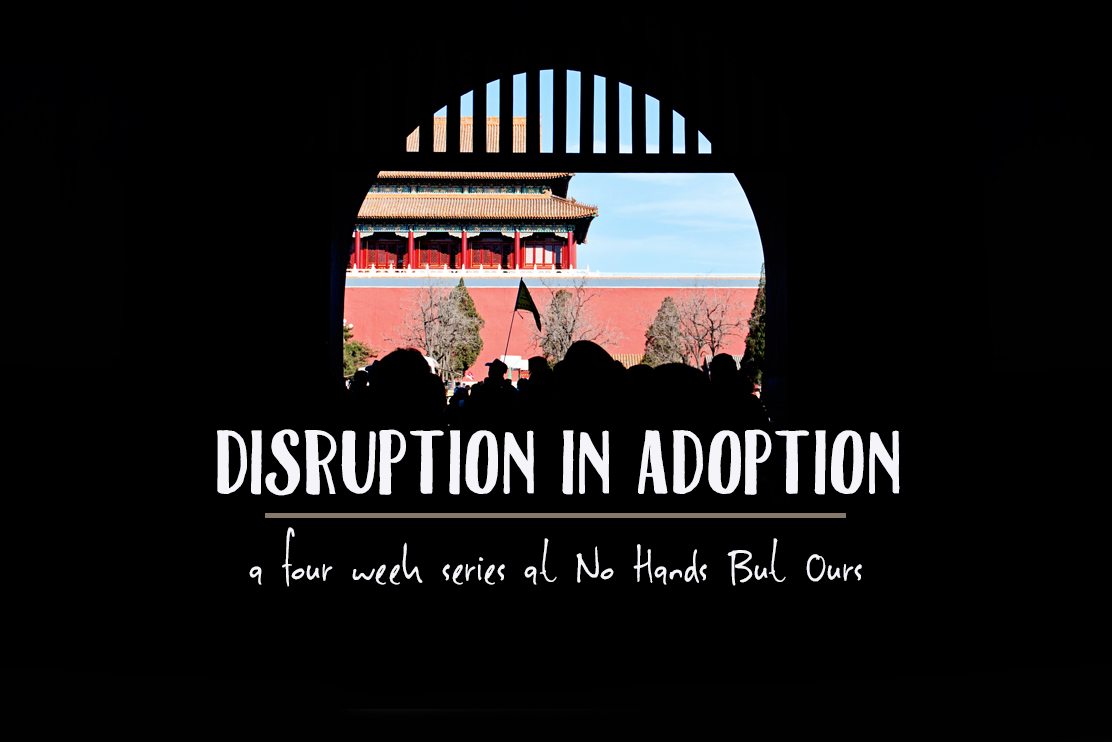The beginning of March marks the start of a series where we will be discussing disruption and dissolution in adoption. We are treading prayerfully and lightly into this realm of the adoption world that is so often avoided. It is hard to talk about. It is complicated. And it is most definitely life altering to both the adoptive family and to the child needing a family.
We are also treading purposefully. Our hope is to present a series of informative posts that represent a multi-faceted look at an extremely complex subject. We also hope to create a place for dialogue to take place – that must take place – as families contemplate adoption, and prepare to adopt their children. As responsible adoptive parents, we must dialogue with our spouses, social workers, and families and friends about this reality, so that when difficulties arise we are better prepared, more informed and have access to a network of support.
In this series we will feature posts from a mother who disrupted, a mother who adopted from a disruption and an orphan advocate who shares her thoughts on the realities of disruption. We hope that over the course of this series the comment section here or on our Facebook page will be used for comments and questions as well, but we ask that all comments refrain from unkindness and/or judgment.
Disruption and dissolution are a heartbreaking reality, but by bringing this tough subject into the light our aim is to better prepare families for the sometimes difficult journey of adoption.
To open this series, we will start with the definitions of key terms as well as some basic facts on disruption and dissolution.
Guardianship and Harmonious Period:
Upon meeting and receiving their child in China, the Adoptive Parents (AP) sign temporary guardianship papers for that child. These papers allow AP to have what is referred to as the harmonious period (also termed the integration period). During this time the AP have not yet signed the legal adoption papers but rather have some time to spend with that child before making the binding commitment. The harmonious period graciously allows the family a brief view into the child and what bringing them into their family might look like. This is also a time of discovery for many families, there may be issues that are quickly apparent that where not listed in the file. These issues may be medical, emotional, institutional delays, or institutional behaviors. If a family is concerned that there is a medical issue which was not known previously, the in country guide can arrange for a medical exam to be performed during this time.
Disruption:
If the AP decide not to complete the adoption when the harmonious period is up, this is called a disruption. The child is returned to the civil affairs office. No legal papers are signed and the guardianship period expires. The child returns to their orphanage and the parents return to the US without a child. The US immigration paperwork which a family completes before traveling to China (I-800) is specific to that one child, so another child cannot be immediately matched during the same trip. The family would need to return to the US and their agency would walk them through their options.
Involuntary Disruption:
If a child is over the age of nine they are required to give a written statement agreeing to be adopted. It is possible that older children are not fully prepared for an upcoming adoption and struggle with the transition. If they refuse to sign the document agreeing to be adopted they will return to the orphanage. This decision and disruption is out of the control of the AP. The same would hold true in this case, the AP would need to return to the US to be rematched.
It is important to note that although this type of disruption does occur, it is not very common. The vast majority of disruptions are parent-led.
Dissolution:
If the AP sign the adoption papers after the harmonious period, but later decide that they no longer wish to parent the child who has been legally adopted it is called a dissolution. This is quite different from a disruption and carries more legal ramifications. At this point, the AP will have promised to never abuse or abandon the child in two different instances, once when submitting the initial intent to adopt the child and then again during the official adoption proceedings. A dissolution is going back on that pledge and is seen in a very negative light by the CCCWA and Provincial officials.
If the dissolution occurs while still in China, paperwork must be completed with the Provincial Civil Affairs. A written statement must be provided in person explaining why the dissolution is occurring. The AP are required to appear before the Civil Affairs officials to legally terminate the adoption registration. If the family has already left the province and traveled to Guangzhou for the visa process they must return to the provincial city to terminate their parental rights. The child’s orphanage may or may not return any donation fees to the parents. The AP may or may not be permitted to be matched with another child after they return home. Additionally, the AP face a strong likelihood of not being permitted to adopt from China again in the future.
If the dissolution occurs once the child is in the US, the AP must immediately contact their adoption agency and submit in writing to the CCCWA the reason behind the dissolution. The agency would assist in the legal aspect of finding a new home for the child. The AP will be added to a list by the CCCWA and will likely not be allowed to adopt from China in the future.
Rematching:
The CCCWA published new rules in January of 2015 which included stricter rematching guidelines. These rules are twofold and greatly impact whether a family can be referred a new child: If there is a true discrepancy between the status of the child and what the file presented, and if the provincial office confirms these issues and approves it, the family may be rematched one they are back in the US. However, if the family “are being too choosy or behave improperly” during their time in China, or discover personal reasons leading to their inability to complete the adoption, the CCCWA will not rematch them and will not allow them to adopt from their country in the future.
It is also important to note that agencies may choose not to rematch a family depending on the circumstances surrounding the disruption or dissolution.
The Child:
A child returned to their Social Welfare Institution after a disruption or dissolution while still in China may or may not be registered again for adoption. They may declare that the child is unadoptable and will age out of the system on their fourteenth birthday. Preparing a child for adoption comes at a monetary expense and time commitment to the SWI, they tend to only prepare files for children who they think families would chose.
This is a very simple summary of some very complicated issues and situations. Please discuss any of these scenarios with your social worker. Education and preparation are key during the entire adoption process. This is especially true in regard to what to expect during the first few hours in China and the months which follow.
Resources:
LWB: Thoughts on Re-Homing from an Adoption Professional
LWB: Realistic Expectations about Adoption Struggles
Rainbow Kids: When Families Fail



























If you adopt from another country (not China), and then go through the process of dissolution, can you then adopt from China? Are there rules regarding this?
Are there any statistics on disruption or dissolution adoptions? How many adoptions end in this process?